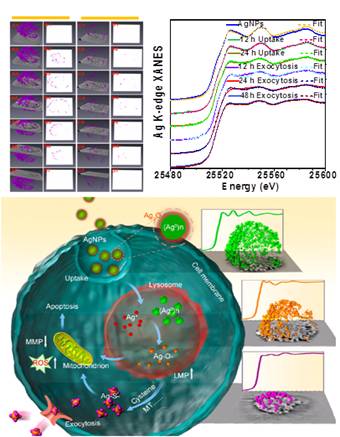| Revealing Chemical Origin of Silver-Nanoparticle Safety by Synchrotron Radiation-Analytical Techniques |
| From: PublishDate:2016-06-03 Hits: |
Compared to the bulk silver, silver nanoparticles (AgNPs) have a smaller size and larger surface area that enable them ability of quick degradation into ions and strong reactivity, and excellent antibacterial property. AgNPs have been thus widely used in antimicrobial products such as medical dressing, articles for babies, and coatings for food packing, refrigerator, and clothing. However, AgNPs are prone to release silver ion in environment and body fluids, which probably causes risks to environment and health. Nowadays, public and the government have paid close attentions to the safety of AgNPs and the dosage range for safe usage. To understand AgNP safety, it is crucial to the correlate biological effects of AgNPs with their potential chemical mechanism such as the chemical transformation during intracellular processes of NPs. However, it is a grand challenge to capture a high-resolution image of metallic NPs in a single cell and the chemical information on intracellular NPs.
Recently, Prof. Chunying Chen’s group has successfully revealed the chemical origin of AgNP cytotoxicity by integrating synchrotron radiation (SR) beam transmission X-ray microscopy (SR-TXM) and SR-X-ray absorption near edge structure (SR-XANES) spectroscopy. In this study, SR-TXM can in situ capture the intracellular 3D accumulation and exocytosis of AgNPs inside a single human monocyte (THP-1), while SR-XANES is capable of revealing the chemical transformation of silver inside cells. The result shows that the cytotoxicity of AgNPs is largely due to the chemical transformation of particulate silver from elemental silver (Ag0)n, to Ag+ ions and Ag-O-, then Ag-S- species. As a result, Ag-S- speciation triggers mitochondrion-involved apoptosis and induces reactive oxygen species to cause cytotoxicity. The study indicates that particulate form of AgNPs, their degraded forms, and the induced ROS play synergetic roles in mediating AgNP cytotoxicity to human monocytes. The present study shows us with an advanced approach for nondestructive detection of intracellular metallic and metal oxide NPs, which provides direct information to reveal the chemical mechanisms of nanotoxicity for nanosafety assessment and application fields. The study will help us understand biomedical effects of AgNPs and will guide the design and synthesis of AgNPs for safe applications. More details about this work can be found in ACS Nano 2015, 9, 6532-6547. It was financially supported by the National Basic Research Program of China, the National Natural Science Foundation of China, the Chinese Academy of Sciences, Beijing Synchrotron Radiation Facility, and Shanghai Synchrotron Radiation Facility. Article: Liming Wang, Tianlu Zhang, Panyun Li, Wanxia Huang, Jinglong Tang, Pengyang Wang, Jing Liu, Qingxi Yuan, Ru Bai, Bai Li, Kai Zhang, Yuliang Zhao, Chunying Chen.* Use of Synchrotron Radiation-Analytical Techniques to Reveal Chemical Origin of Silver-Nanoparticle Cytotoxicity. ACS Nano 9 (2015), 6532-6547.
|
|
|
| Chinese
- Beamline 1W1 of BSRF started to runoperate in the couplingparasitic mode of BEPCII
- Synthesis of High Performance Polymer Materials for Field Effect-Transistors
- Surfactant molecular aggregates in green solvents
- GIXRD has played an important role in the characterization of organic thin-film transistors
Copyright © 2011 - 2012 Beijing Synchrotron Radiation Facility


